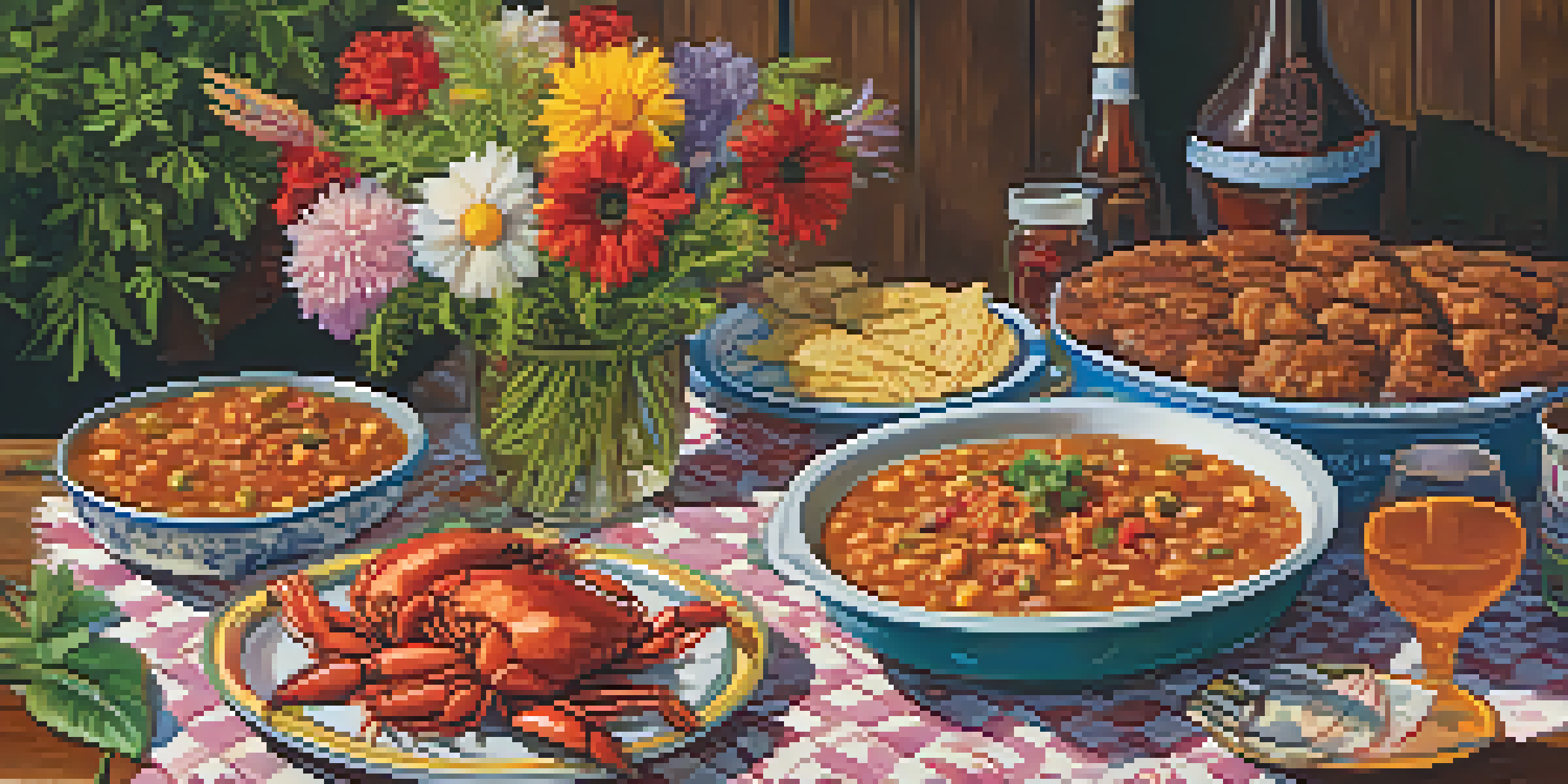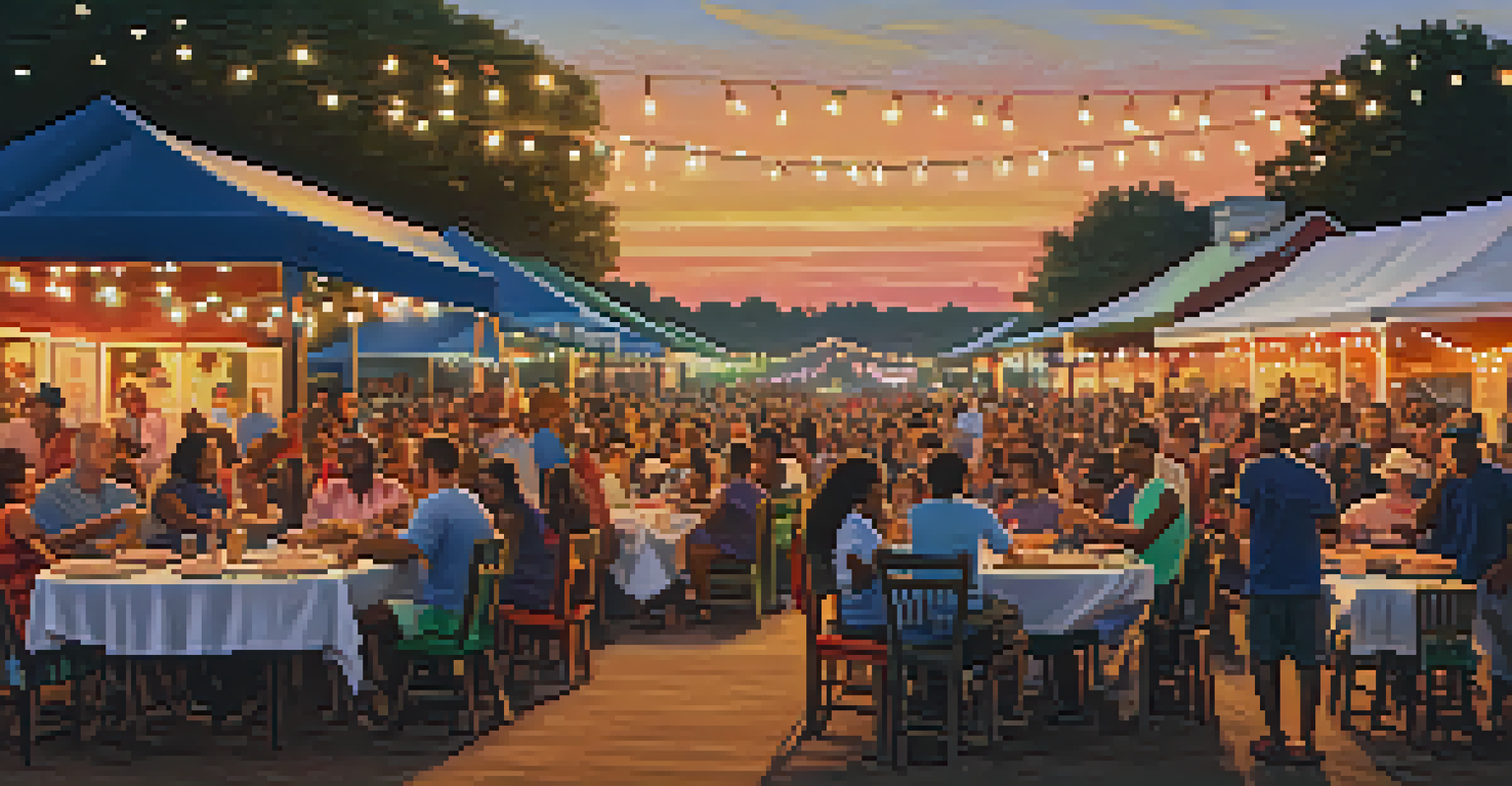Cajun and Creole Cuisine: A Culinary Journey in Louisiana

Understanding Cajun and Creole: The Basics
Cajun and Creole cuisine are two distinct culinary traditions that originated in Louisiana, each with its own unique flavors and influences. Cajun cuisine is rooted in the cooking of French-speaking Acadians who settled in the rural bayous, while Creole cuisine reflects the rich cultural melting pot of New Orleans, combining French, Spanish, African, and Caribbean elements. Understanding these differences is key to appreciating the depth of Louisiana's culinary landscape.
Food is our common ground, a universal experience.
At first glance, you might think they are interchangeable, but the nuances set them apart. For instance, Cajun dishes often emphasize rustic, hearty ingredients like rice, sausage, and seafood, while Creole cuisine showcases more elaborate presentations and a broader range of spices. This diversity not only highlights the region's agricultural bounty but also tells a story of cultural exchange and adaptation.
As you delve deeper into these culinary traditions, you'll find that both Cajun and Creole cuisines prioritize community and sharing, often bringing families and friends together over a pot of gumbo or jambalaya. This communal aspect is at the heart of Louisiana's food culture, emphasizing the joy of gathering and feasting on homemade dishes.
The Role of Spices and Seasoning in Louisiana Cuisine
Spices are the backbone of Cajun and Creole cooking, transforming simple ingredients into unforgettable dishes. You'll commonly encounter a blend known as 'Cajun seasoning,' which typically includes paprika, cayenne pepper, garlic powder, and onion powder, creating a bold flavor profile that’s hard to resist. This combination reflects the region's love for heat and complexity in every bite.

In contrast, Creole seasoning often features a more nuanced approach with the addition of herbs like thyme and oregano, balancing out the heat with fragrant components. Both seasonings embody the essence of Louisiana cooking, allowing chefs to express their creativity while staying true to tradition. The use of fresh herbs, spices, and the holy trinity of vegetables—onions, bell peppers, and celery—are essential in crafting the perfect dish.
Cajun vs. Creole: Key Differences
Cajun cuisine focuses on rustic, hearty dishes, while Creole cuisine showcases a blend of diverse cultural influences and more elaborate presentations.
The mastery of these spices and blends is often passed down through generations, making each family’s recipe unique. Whether it's a spicy crawfish étouffée or a rich red beans and rice, the seasoning choices reflect the cook's heritage and personal touch, giving each dish a story of its own.
Essential Dishes: Gumbo, Jambalaya, and Beyond
No discussion of Cajun and Creole cuisine would be complete without mentioning gumbo and jambalaya, two iconic dishes that showcase the culinary traditions of Louisiana. Gumbo is a hearty stew made with a strong roux, a blend of meats, seafood, and spices, served over rice. This dish can vary significantly based on personal preference, with each chef adding their twist, making it a beloved staple at gatherings.
Cooking is like love. It should be entered into with abandon or not at all.
On the other hand, jambalaya is a one-pot dish that combines rice with various meats and vegetables, cooked together to create a flavorful and filling meal. It's often considered a party dish, perfect for feeding a crowd, and embodies the spirit of Louisiana's vibrant culture. Both dishes reflect the resourcefulness of Cajun and Creole cooking, where every ingredient is cherished and utilized to its fullest.
Beyond these two, you'll find a plethora of dishes that highlight the region's culinary diversity, such as étouffée, po'boys, and beignets. Each dish tells a story, whether it's about the ingredients sourced from local markets or the cultural influences that shape its preparation, inviting you to taste Louisiana's rich history.
The Influence of Local Ingredients on Flavors
Louisiana's unique geography plays a pivotal role in shaping the flavors of Cajun and Creole cuisine. The state's fertile soil, abundant waterways, and rich agricultural heritage allow for a diverse range of ingredients, from seafood to spices, to thrive. This local bounty not only enhances the freshness of the dishes but also fosters a deep connection between the food and its environment.
Seafood is a significant component, with shrimp, crawfish, and oysters being staples in many recipes. The proximity to the Gulf of Mexico ensures that these ingredients are always fresh, adding a distinct flavor that can’t be replicated. Additionally, local farmers provide an array of vegetables, herbs, and spices, ensuring that every meal is infused with the essence of Louisiana.
Spices Define Louisiana Flavors
The unique spice blends in Cajun and Creole cooking, such as Cajun seasoning and Creole seasoning, transform simple ingredients into bold and unforgettable dishes.
This emphasis on local sourcing not only supports the community but also encourages sustainability in cooking practices. Chefs in Louisiana often prioritize seasonal ingredients, allowing them to celebrate the region's culinary heritage while adapting to what nature provides, making each meal a reflection of the time and place.
Cultural Influences: A Melting Pot of Flavors
Cajun and Creole cuisines are a testament to Louisiana's rich cultural tapestry, influenced by various groups over centuries. The fusion of French, Spanish, African, and Native American ingredients and cooking techniques reflects the state's history of migration and settlement. Each culture brought its unique culinary practices, resulting in a vibrant and diverse food scene that's unlike any other in the United States.
For example, the French influence is evident in the use of herbs and sauces, while African traditions contribute to the emphasis on bold flavors and communal cooking. Meanwhile, Spanish influences are seen in dishes like paella, showcasing the blending of cultures that has occurred over generations. This culinary cross-pollination creates dishes that are not only delicious but also steeped in history.
Understanding these cultural influences enriches your culinary journey through Louisiana. Each bite becomes a celebration of the people who have shaped the region, offering a delicious insight into the stories and traditions that continue to thrive in Cajun and Creole kitchens today.
The Importance of Community and Family in Food Culture
In Louisiana, food is more than just sustenance; it's a way to bring people together. The act of cooking and sharing meals is deeply rooted in the community, creating bonds that transcend generations. Family recipes are cherished and passed down, often becoming a source of pride and nostalgia for many Louisianans.
Gatherings often revolve around food, with celebrations featuring large pots of gumbo or jambalaya, showcasing the importance of sharing and hospitality. These communal meals create a sense of belonging, allowing people to connect over shared experiences and flavors. Whether it's a holiday feast or a Saturday cookout, food serves as a focal point for gathering friends and family.
Community is Central to Food Culture
In Louisiana, food serves as a vital connector for families and communities, often celebrated through shared meals and cherished recipes passed down through generations.
Moreover, local festivals and events often celebrate Cajun and Creole cuisine, allowing communities to showcase their culinary traditions. These occasions not only highlight the region's food culture but also foster a sense of pride and unity, reinforcing the idea that food is a vital part of Louisiana's identity.
Exploring Cajun and Creole Cuisine: A Culinary Adventure
Embarking on a culinary journey through Cajun and Creole cuisine is like diving into a rich, flavorful tapestry woven from history, culture, and community. Whether you're visiting Louisiana or experimenting in your own kitchen, the key is to embrace the spirit of these traditions. Don't be afraid to get your hands dirty and make these dishes your own, adding your personal touch to family recipes.
Consider hosting a dinner party featuring a spread of Cajun and Creole dishes, inviting friends and family to share in the experience. As you cook, share stories about the origins of each dish, explaining how different cultures have influenced the flavors you’re presenting. This not only enriches the meal but also creates an engaging atmosphere that celebrates the essence of Louisiana.

Ultimately, Cajun and Creole cuisine invites you to explore, taste, and connect with the vibrant culture of Louisiana. So roll up your sleeves, gather your ingredients, and let the flavors of this remarkable culinary tradition inspire you to create lasting memories around the dinner table.